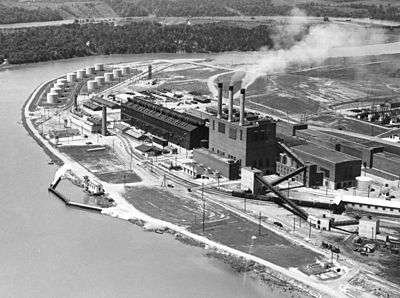S-50 (Manhattan Project)

S-50 was a Manhattan Project production facility which enriched uranium by liquid thermal diffusion; one of three Manhattan Project uranium enrichment plants at the Clinton Engineer Works in Oak Ridge, Tennessee.
The thermal diffusion process for uranium isotope separation, which had been developed by U.S. Navy scientists, was not one of the uranium enrichment technologies initially selected for use in the Army-led Manhattan Project. However, in June 1944, after reviewing progress of Philip Abelson's experiments on thermal diffusion at the Philadelphia Navy Yard, a team of Manhattan Project experts recommended that a thermal diffusion plant be built to augment production capacity from the electromagnetic separation process then operating at the Y-12 plant in Oak Ridge.
On June 18, 1944, Major General Leslie Groves contracted with the H.K. Ferguson Company of Cleveland, Ohio, to build the S-50 plant. He gave the company just 90 days (half the time optimistically estimated to be necessary) to complete the project, which included installation of 2,142 48-foot-tall (15 m) copper and nickel diffusion columns. The facility was located adjacent to the K-25 site, where the massive gaseous diffusion plant was under construction. With the help of creative shortcuts, such as using passenger trains to deliver some construction materials, Ferguson met its seemingly impossible deadline. On September 16, 1944, the S-50 enrichment plant began partial operation. Union Carbide was the operating contractor. Steam was obtained from the K-25 powerhouse. Initially, leaks limited production at S-50, but by January 1945 the facility began substantial production of uranium enriched to about 0.85% U-235. As of March 15, 1945, all 21 production "racks" were operating.
In the face of problems with all three enrichment processes, in April 1945 Robert Oppenheimer ordered that all three enrichment processes be run in series. The S-50 thermal diffusion process became the first stage of enrichment, achieving enrichment levels of less than 2% uranium-235. This material was fed to the gaseous diffusion process in the K-25 plant, which produced a product enriched to about 23% U-235. That product was, in turn, fed into the calutrons at Y-12, which boosted the U-235 concentration to about 84%, providing the uranium used in the Little Boy atomic bomb that was dropped over Hiroshima, Japan, on August 6, 1945.
The S-50 facility was completely shut down on September 9, 1945, less than one year after it began operation. In the early post-war years the building was used for military and atomic energy research and development projects, notably including work on the feasibility of Aircraft Nuclear Propulsion, but it was torn down not long thereafter.
Sources
- Manhattan Project History: Clinton Engineer Works (Oak Ridge) S-50 Plant, The Manhattan Project Heritage Preservation Association.
- The Navy and Thermal Diffusion and K-25 Gaseous Diffusion Process Building, Oak Ridge, Tennessee, United States Department of Energy Office of History and Heritage Resources.
- Oak Ridge, Tennessee, The Atomic Heritage Foundation.
- Carey Sublette, Chronology For The Origin Of Atomic Weapons, In: Nuclear Weapons Frequently Asked Questions, Version 2.13: 15 May 1997.
- http://www.usace.army.mil/publications/misc/un20/c-20.pdf
Coordinates: 35°54′58″N 84°24′43″W / 35.91611°N 84.41194°W